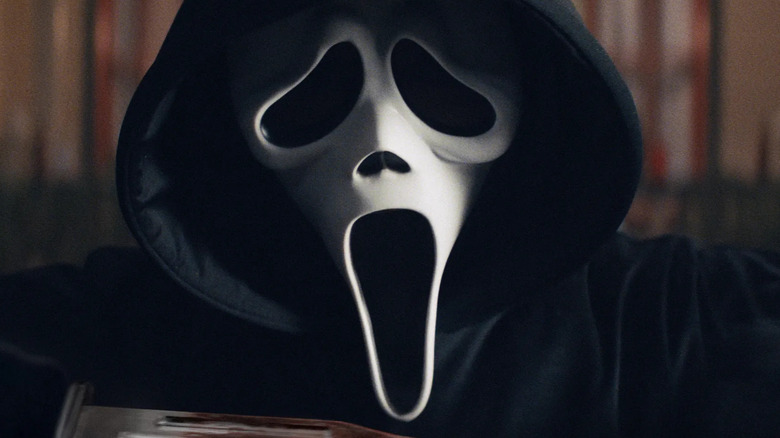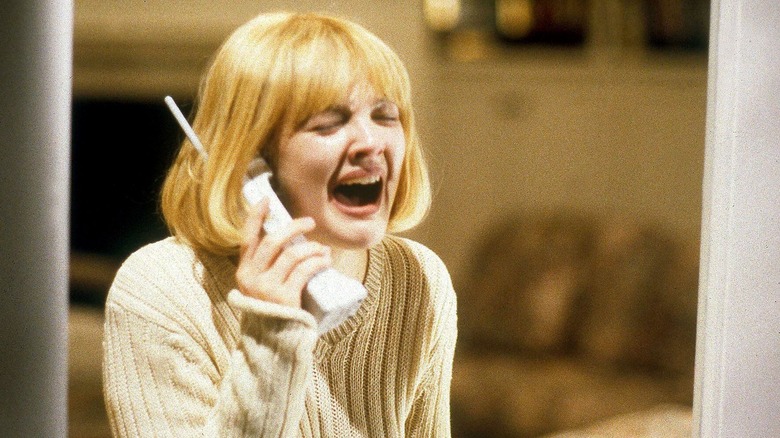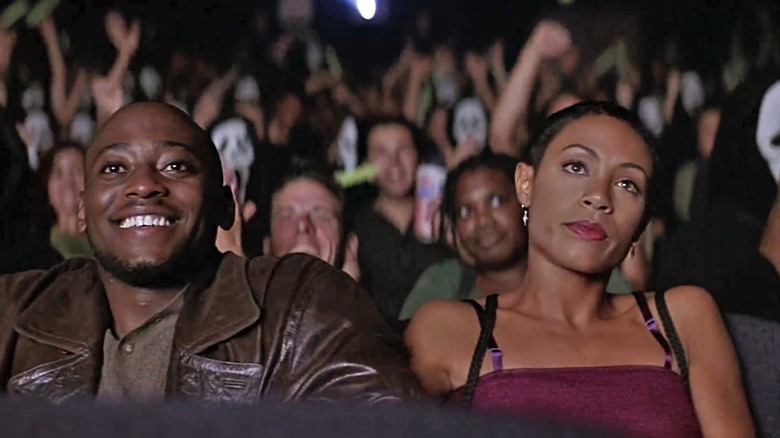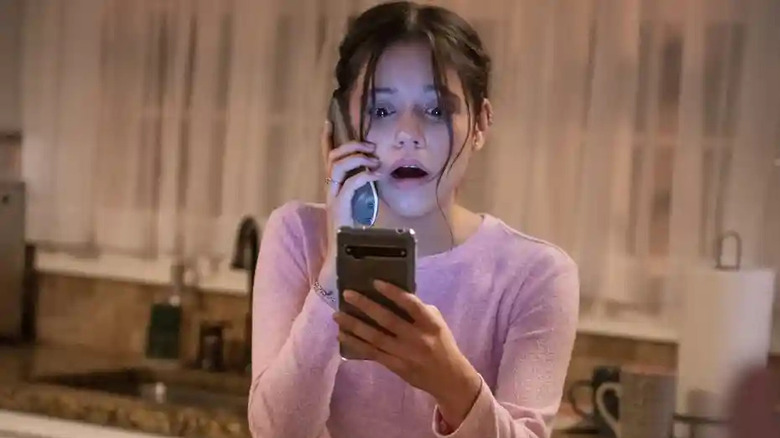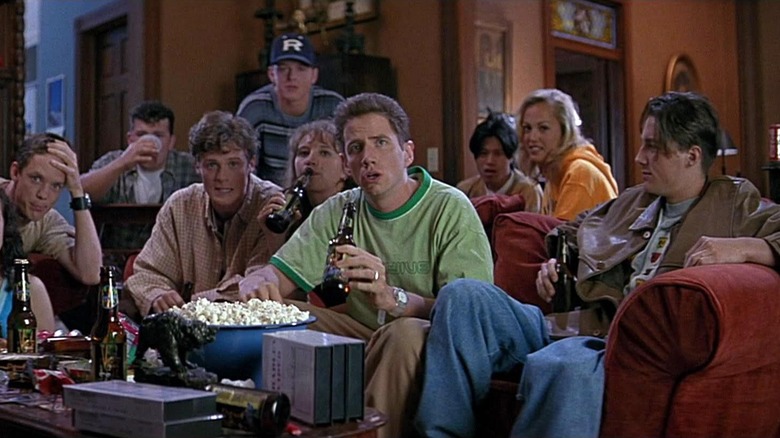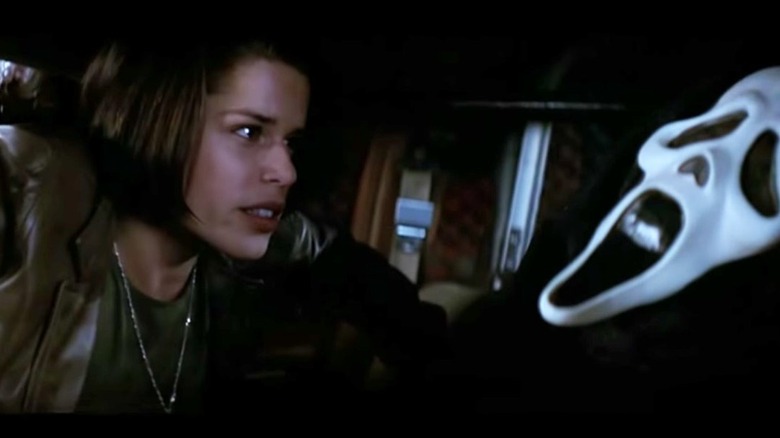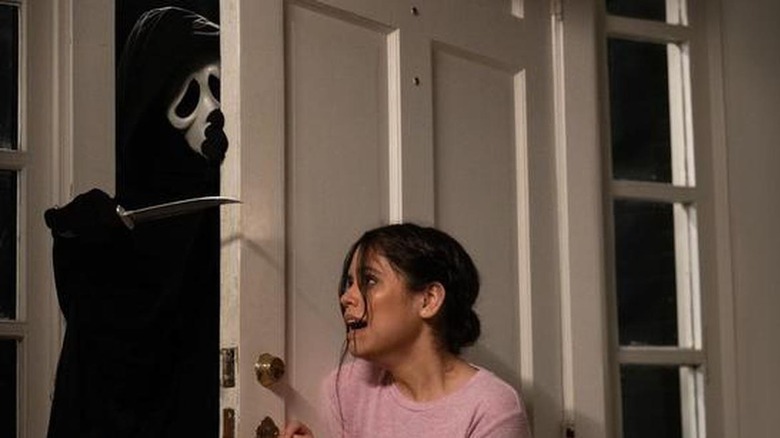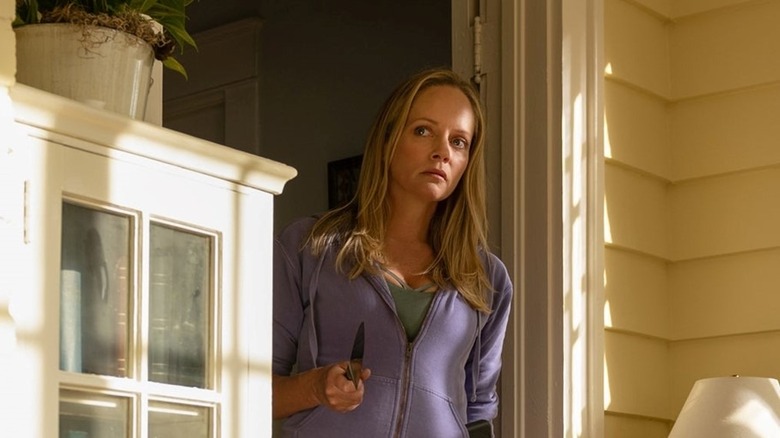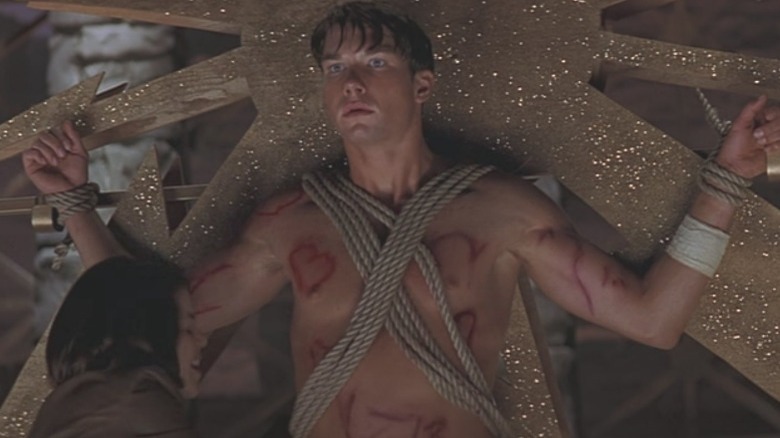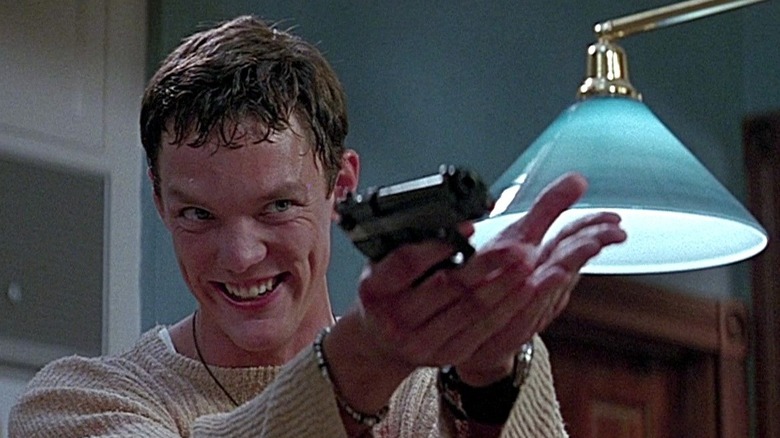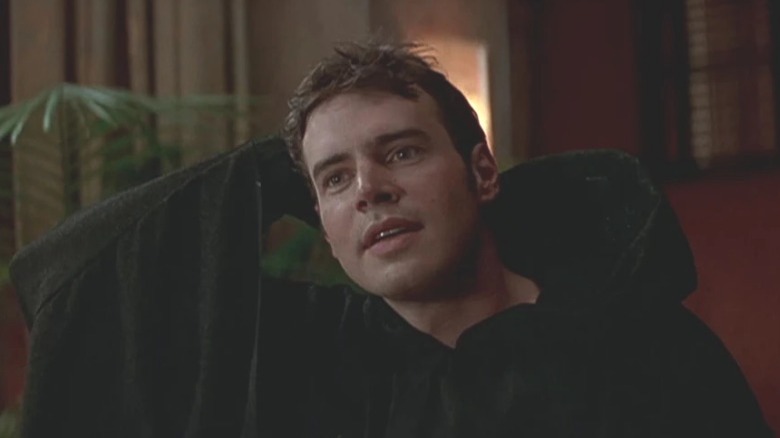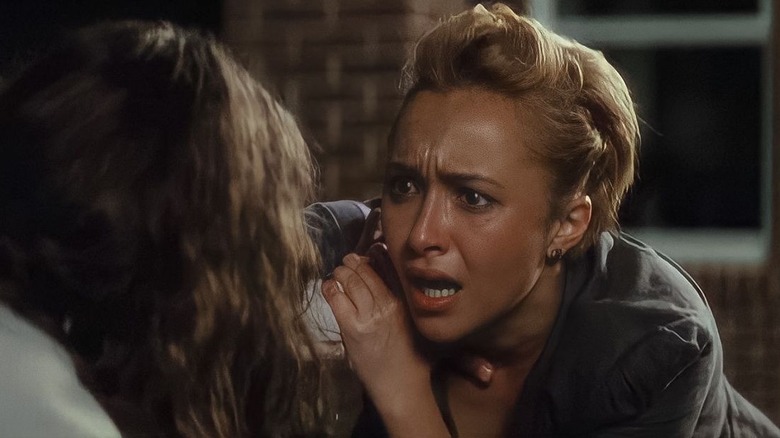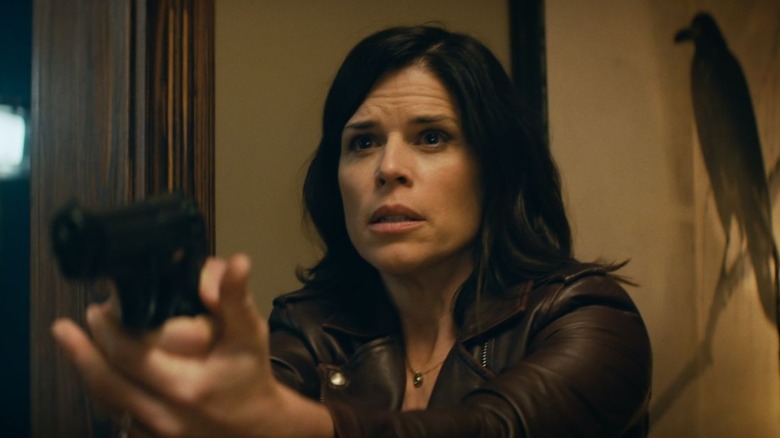Things That Happen In Every Scream Movie
One of the most enduring and popular slasher movie franchises is "Scream," which has been delightfully frightening audiences since the original film's release in 1996. The series follows Sidney Prescott (Neve Campbell), a woman whose senior year of high school is completely upended when a masked murderer known as Ghostface launches a bloody killing spree in her California hometown of Woodsboro — with Sidney's friends and the killers themselves seemingly aware of the rules inherent in these kinds of movies and using them to the best of their abilities to survive.
After defeating the first Ghostface(s), Sidney faces different iterations of the serial killer over the subsequent years, assisted by investigative reporter Gale Weathers (Courteney Cox) and Sheriff Deputy Dewey Riley (David Arquette). Across all five movies produced so far, there are tropes that consistently appear in each of the installments, lending a self-aware sense of familiarity to Sidney's confrontation with the line of slashers alongside all the bloody thrills that come with the slasher movie genre.
Here are all the major recurring elements in the "Scream" movies, along with how the metatextual horror franchise occasionally subverts audience expectations by changing up these well-worn tropes to great effect.
What's your favorite scary movie?
"Scream" takes place in a world where many popular horror franchises exist, with the characters directly referencing movies like "Halloween" and "Friday the 13th." One common refrain across all the "Scream" films is Ghostface presenting his/her/their potential victims with the infamous question "What's your favorite scary movie?" before attacking. This line appeared in the prologue to the original "Scream" and has resurfaced in its growing line of sequels, setting the metatextual tone of the franchise while becoming something of a catchphrase for the entire film series.
This self-aware approach to the genre doesn't stop with that well-worn question, but extends to multiple discussions by the characters about the nature of horror movies. Characters in "Scream" films often share the unwritten rules that result in people either getting killed off or surviving in horror movies, using them to their advantage to stay one step ahead of Ghostface. With its Hollywood premise, "Scream 3" goes into the behind-the-scenes processes of making horror pictures, while the fifth "Scream" is a meditation on toxic movie fandoms.
A gruesome opening attack immediately sets the tone
While the "Scream" series has gruesomely dispatched dozens of victims over the course of five films, many of the movies' most memorable kills occur right in each installment's respective prologue sequence. Introducing the first victims of the latest Ghostface, the masked serial killer(s) taunt and outmaneuver their prey before striking, often resulting in a particularly graphic murder. This inciting attack immediately sets the tone for the remainder of the film, heralding the arrival of a new serial killer to menace the protagonists while retaining the series' taut pacing, unflinching violence, and sense of self-awareness about the horror genre.
Perhaps the most infamous prologue in the franchise's history is in the 1996 original film, with Casey Becker (Drew Barrymore) menaced and murdered by Ghostface along with her boyfriend Steve (Kevin Patrick Walls). Many of the subsequent sequels would similarly open with another pair of victims perishing at the hands of a new Ghostface kicking off their own killing spree, including Maureen (Jada Pinkett-Smith) and Phil's (Omar Epps) date night gone wrong in "Scream 2." The fifth "Scream" subverts the formula somewhat, opening with a harrowing assault in the prologue on main character Tara Carpenter (Jenna Ortega) that the high schooler manages to survive, albeit gravely wounded.
The phone is Ghostface's ultimate intimidation weapon
With their menacing voice simulated by a voice changer behind the mask, Ghostface often taunts and threatens their prey before moving to strike. This is usually done via Ghostface heralding their arrival by calling their intended victim on the phone, usually starting out innocently enough before quickly shifting into sadistic terror. The phone trope is the first element that introduces the "Scream" franchise, with Casey receiving a fateful call from her soon-to-be killers, and it continues throughout the film series, often just prior to another horrific attack by the masked murderers.
There have also been self-aware moments acknowledging the franchise's prominent use of phones and the cat-and-mouse games Ghostface plays with their targets. In the beginning of "Scream 3," Cotton Weary (Liev Schreiber) refuses to play Ghostface's phone game, but he and his girlfriend Christine (Kelly Rutherford) are murdered anyway. The fifth "Scream" shows Ghostface using smartphone apps to terrify their victims, including messing with a smart home's security system, before appearing on the scene to attack Tara and shifting the trope to more modern possibilities than its predecessors.
Parties are Ghostface's ideal killing ground
One recurring element across the "Scream" movies is that many of the characters are distracted by a party as the slasher seizes the opportunity to claim new victims. In the original "Scream," Tatum Riley (Rose McGowan) is murdered by Ghostface after being lured away from a party celebrating her high school's temporary closure. In "Scream 2," Ghostface kills sorority sister Cici Cooper (Sarah Michelle Gellar) while the characters are attending a sorority party in a different house. This trend continues in subsequent sequels, with Ghostface striking at different parties attended by the main characters, from birthday celebrations to get-togethers for the film-within-a-film franchise "Stab."
There are slight changes to the party trope within the "Scream" movies, with Roman Bridger (Scott Foley) faking his death at his own birthday party in "Scream 3" to continue his killing spree unabated. Rather than being killed at a bigger gathering, Vince Schneider (Kyle Gallner) is killed after a night out at a bar, effectively ending his one-man party as Ghostface adds to their growing kill count. If there's anyone who knows how to cut a good time short, Ghostface is more than happy to oblige in delivering the ultimate buzz kill.
Cars are also a Ghostface magnet
In addition to using parties as potential hunting grounds, Ghostface has a tendency to claim victims when they are around cars, either when they attempt to enter them or are already waiting inside. From police cruisers stationed outside the homes of persons of interest for protection to media vans that become impromptu slaughterhouses, automobiles are not a safe space in the "Scream" movies. This bloody distinction began with news cameraman Kenny Brown (W. Earl Brown) in the original 1996 movie, as he emerged from his van only to have his throat slit.
The most ambitious car-based killings in the franchise to date take place in "Scream 2," with Ghostface killing two police officers and Sidney's college friend Haellie (Elise Neal) after a careening car ride. This is preceded by Sidney's friend and college classmate Randy Meeks (Jamie Kennedy) being brutally murdered by Ghostface in a news van after deducing the killer's motives. An honorable mention for most memorable car-related murder in the franchise goes to "Scream 4," with Sidney's former publicist Rebecca Walters (Alison Brie) stalked in a parking garage before being killed and flung off the garage's top level.
A good "Scream" rule to follow whenever Ghostface comes to town? Avoid parties and cars to evade the killer's attention.
Ghostface often gets knocked around on the hunt
While racking up an impressive body count in each installment, Ghostface is not some highly trained killer or supernatural slasher like Freddy Krueger or Jason Voorhees. Often, the villains under the familiar pale mask and black cloak are seemingly ordinary people who became murderously unhinged for a variety of reasons. This lack of experience, coupled with the natural limitations in movement and vision of the Ghostface costume, means that the killers are going to stumble and get pushed around before pulling off some of their murders.
In the midst of heated chases throughout the "Scream" movies, the various Ghostfaces have been tripped, kicked, punched and had objects slammed or thrown into them. Some of the killers have fallen over on their own in the heat of the moment, accidentally running into furniture or stairs, resulting in them taking a quick tumble before recovering to resume the hunt. It's this tendency towards clumsiness that serves as the saving grace for many "Scream" characters, granting them precious time to properly react or escape.
Local law enforcement is no match for Ghostface
With a serial killer on the loose and leaving a gruesomely bloody trail in their wake, the local police force stands on high alert quickly in every "Scream" movie, determined to stop any additional murders. However, for all their coordination and resources, the police always wind up being added to Ghostface's growing body count, killed just as easily as most of the murderer's prey. In fact, the assignment to defend Sidney and the other main characters of the "Scream" movies is a virtually guaranteed kiss of death for any law enforcement personnel assigned to security duty.
In the first two "Scream" movies and "Scream 4," the police assigned to safeguard the characters are always ambushed in their own cars, butchered by Ghostface while their attention is elsewhere. "Scream 3" expands this to include security officers, with studio guards killed in the 2000 film and hospital security murdered in the fifth "Scream." The 2022 sequel has Ghostface go out of their way to target Woodsboro's Sheriff Judy Hicks (Marley Shelton), murdering her and her son at their own home. Wearing a badge in the "Scream" movies comes with as dangerous a reputation as wearing a red shirt in the original "Star Trek" series.
There's always a red herring before the true killer(s) reveal themselves
Part of the fun in the "Scream" movies is trying to figure out who the killers are before they are unmasked by the film's ending. With virtually all the main characters but Sidney, Gale, and Dewey as prime suspects, this modern whodunnit is full of plot twists and misdirection to keep the survivors and audience guessing throughout the story. Despite all their experience, the survivors always believe the wrong person to be the killer before they are lethally corrected about their previous assumption.
In the original "Scream," Cotton is believed to be a suspect along with Sidney's classmate Randy, with Billy Loomis (Skeet Ulrich) diverting suspicion from himself with his friend's help. This experience leads Sidney to inaccurately suspect her boyfriend Derek (Jerry O'Connell) of being a murderer in "Scream 2." In "Scream 3," the true killer, Roman, fakes his death to allow the survivors to suspect other characters. "Scream 4" has the slashers frame Trevor Sheldon (Nico Tortella) for the murders, with the killers in the fifth "Scream" similarly setting up Sam Carpenter (Melissa Barrera) to appear as the murderer before revealing themselves.
Ghostface is not above using a gun
While most slashers stick with manual weapons to dispatch their numerous victims, from Leatherface's chain saw in "The Texas Chain Saw Massacre" to Michael Myers' kitchen knife in "Halloween," Ghostface has a surprising propensity to use firearms to get the job done. This distinction helps further set Ghostface apart from many of their slasher movie contemporaries and has been a staple for the antagonist since the original "Scream." Aside from simply distinguishing Ghostface as a more pragmatic killer, it also makes the masked murderer far more deadly than someone relying on more analog weaponry that requires them to get up close and personal.
Billy was the first Ghostface to use a gun, shooting and gravely wounding Randy after revealing himself to be the killer. Every subsequent finale to the "Scream" sequels has heavily involved the use of guns, with Ghostface executing Derek with a well-aimed pistol shot in "Scream 2" while Roman believes he killed Sidney by shooting her in "Scream 3." Sidney may have gained a reputation for using a pistol to put down any killers that menace her, but Ghostface similarly has been known to pack heat to even the odds.
Ghostface(s) always has a convoluted motive
After unmasking, each of the Ghostfaces conveniently explain exactly why they've been killing people around Sidney and her sleepy hometown of Woodsboro, often with increasingly odd motivations behind their crimes. The first three films' antagonists are seeking revenge on Sidney because of perceived slights from her mother Maureen Prescott (Lynn McRee) and fallout from the initial killing spree. The later movies in the series shifted the motivation to the film-within-a-film franchise "Stab," and the resulting fame that it brought to Sidney and her fellow survivors from their repeated ordeals.
Billy murders Maureen after learning she was having an affair with his father and decides to continue to ruin the Prescott family. In "Scream 2," Billy's mother Debbie Salt (Laurie Metcalf) wants to avenge her son's death in the original "Scream," while the impetus for Roman's killing spree in "Scream 3" is due to Maureen refusing to accept him as her son. In "Scream 4," Sidney's cousin Jill Roberts (Emma Roberts) is jealous of the fame that surviving the multiple killing sprees has brought to Sidney and seeks to orchestrate her own survivor story. The fifth "Scream" has the wildest killer motivation yet, with Richie Kirsch (Jack Quaid) and Amber Freeman (Mikey Madison) out to give the "Stab" series more interesting source material to work with through their crimes.
A survivor endures a life-threatening injury
Just because Sidney and several of her friends have survived their encounters with Ghostface doesn't mean they haven't walked away physically unscathed from each experience. Several of the main characters are shot, slashed, or stabbed by the killers before revealing that they've managed to survive their wounds and live to fight another day. These near-death experiences often come at the end of each "Scream" movie, leaving audiences to wonder if Ghostface just claimed another victim before the nightmare is brought to a decisive end.
In the first two movies, Dewey is stabbed multiple times by Ghostface, only to barely survive and be taken away by paramedics to make his recovery. Sidney is the presumed final victim in "Scream 3" and "Scream 4," shot in the former and stabbed in the latter, only to feign the full extent of her injuries to get Ghostface to drop their guard. Sam is injured during her fight against the Ghostfaces in the fifth "Scream," regaining her strength to finish off Richie, while the movie subverts expectations by killing Dewey despite his legacy character status. One notable addition to this trope is that Kirby Reed (Hayden Panettierre), who was presumed stabbed to death in "Scream 4," is revealed in the fifth movie to have survived and is slated to return to the franchise in the future.
Someone delivers a kill shot to ensure Ghostface is dead
With their propensity for endless sequels, slasher movie franchises are known to have their respective serial killers survive even the most grievous injuries to resume their bloody rampages. With the "Scream" films maintaining a sense of self-awareness about horror cinema and its common tropes, Sidney and her fellow survivors leave nothing to chance to ensure that the Ghostfaces are truly dead. This results in every "Scream" movie ending with the survivors dealing one last shot to put down Ghostface for good, rather than let them complete one final scare.
The first three "Scream" movies end with the survivors shooting the killers in the head, often after they've risen for one last attack, with the final gunshot killing them instantly. "Scream 4" concludes with Sidney defibrillating the villainous Jill before shooting her point blank in the chest, killing her evil niece. The fifth "Scream" gives the kill shot honor to its new protagonists, with Sam viciously stabbing Richie to death while her sister Tara shoots Amber after she rises back up.
